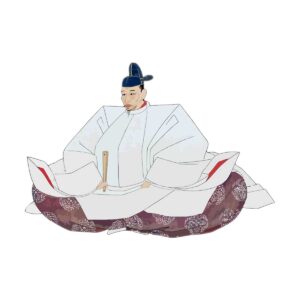
Samurai warrior, seized control of the Momoyama government.
Nicknamed Fujikichiro, he was first called Kinoshita, later Hashiba, and then Toyotomi.
Later he was called Toyotomi, a name that was highly esteemed in later generations.
He was born in Owari Province (Aichi Prefecture), and served Nobunaga at his eldest age, and distinguished himself through his military exploits with his talent and agility in all directions.
In June 1582, he defeated Akechi Mitsuhide at Yamazaki in the Honnoji Incident, paving the way for his seizure of power.
In 1583, he built Osaka Castle.
In 1585, he was promoted to the position of First Vice-Minister of the Privy Seal, and in 1586, to Grand Minister of State.
He went to war against Joseon in 1592 (Bunroku 1) and reconquered in 1597 (Keicho 2).
On August 18, 1598, he turned to Fushimi Castle.
He was sixty-three years old.
Hideyoshi was a great admirer of waka poetry, renga, and Noh drama, and was especially fond of the tea ceremony.
In 1576, he received a large scroll painting from Nobunaga for his work in building the castle at Azuchi, and in December of the same year, he received a cauldron of the famous “Otogozen” tea kettle during his conquest of Tajima and Harima. In 1582, after Mitsuhide’s downfall, he was given the title of “the first king of the Chugoku region.
After Mitsuhide’s defeat in 1582, he held tea ceremonies at Honkokuji Temple on July 2, at Yamazaki Castle on November 7 and January 5, 1583, and at Sakamoto Castle, followed by a series of tea ceremonies at Osaka Castle in June 1583. In January 1584, he held a tea ceremony at Yamasanomaru, and in January 1585, he went to Arima Onsen, and in March of the same year, he created eleven tea ceremony rooms in the style of kakecha-ya at Souminin in the Daitokuji Temple, inviting 143 samurai and commoners.
In March of the same year, he created eleven kakecha-ya (tea house) style seats at Daitokuji Temple’s Somiin Temple in the mountains and invited one hundred and forty-three people, including the nobles and the common people. In October of the same year, the tea ceremony was held at the Forbidden Middle School and the Imperial Household.
In October of the same year, he presented tea to Emperor Shojincho at the Imperial Palace, where he moved the golden tea ceremony room he had built in the Osaka Castle Honmaru and gave the title of Rikyu to Muneyoshi.
In January 1587, he held another grand tea ceremony at Osaka Castle, followed by the famous Kitano Grand Tea Ceremony on October 1 of the same year.
The tea ceremony was held at the famous Kitano Grand Tea Ceremony, and the sign read, “If you have any interest in Japanese tea ceremonies, you may attend from anywhere in Japan, even from foreign countries. He served tea to a wide range of people, including court nobles, samurai, townspeople, and peasants, as well as Wabi-nin (Wabi-sha) such as Nogan of Yamashina and Ikka of Mino.
In 1590, he went to Odawara.
On February 28, 1591, he died as a gift to Rikyu.
In April 1592, he rode his horse to Nagoya in Hizen Province (Chinzei-machi, Karatsu City, Saga Prefecture) to lead the army in the conquest of Korea, where he also held a tea ceremony in a mountain village and invited many generals.
In 1594, he moved to Fushimi Castle, where he again established Yamasanomaru, a tea house and a study center, and according to the chronicle of Seisho Shokan, “There is a tea house, a fireplace, and a place where you can enjoy yourself wherever your heart desires.
It is a place where you can enjoy yourself wherever your heart desires. A few steps out of the main hall you will come to the main gate, and once inside the gate you will find the high hall, which is named after the place where the study was held.
In his later years, on March 15, 1598, he held a cherry-blossom viewing party in Daigo, and had eight teahouses set up for the event.
On the one hand, Hideyoshi’s tea was a golden tea befitting the golden and brilliant power that brought the “Momoyama Period” into existence, and it was also a tea to show off his “tools” as a symbol of his power, and on the other hand, it was a tea for amusement in the style of a “teahouse” based on his unique sense of the common people, and on the other hand, it was a tea for Rikyu as a standard of “culture and learning. On the other hand, it was Rikyu’s Wabicha as a standard of “culture and learning”, and Hideyoshi’s tea was always a unified use of these three aspects with his agile political sense.
However, as for his philosophy of tea, Hideyoshi was deeply influenced by Rikyu, and he himself wrote a poem, “It is known that the tea ceremony is only when you understand the heart of a person who is not there,” and in his “Shoin Fuwa Teisho,” he strictly prescribed the Wabi-style tea ceremony of one soup and three dishes. After Rikyu’s death, he remembered Rikyu’s tea in every instance.
We can see Hideyoshi’s openness to the world of tea in “Sotan Diary” and other writings.
It is said that Hideyoshi did not like the black color of Rikyu’s Raku tea bowls, which eventually led to the appearance of Furuta Oribe and Shino ware and Oribe ware, which were in line with the times.
Hideyoshi, no less than Nobunaga, protected and encouraged the pottery industry, and there is already a certificate of a seizure order issued in Ibe Village, Bizen Province (Ibe, Bizen Town, Waki County, Okayama Prefecture).
The Bunroku-Keicho period (1592-8) resulted in the emergence of many new domestic kilns by Joseon potters, and it can be said that Japan’s pottery industry under Hideyoshi made a major epoch-making development.



